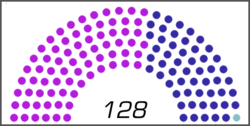United States Congress
| United States Congress | |
|---|---|

| |
| Seal of the U.S. Congress | |

| |
| United States Capitol | |
| Type | Bicameral |
| Houses | Senate House of Representatives |
| History | |
| Founded | March 4, 1789 |
| Preceded by | Congress of the Confederation |
| Leadership | |
| President pro tempore of the Senate | Choi Sung-min (DRC) since January 3, 2277 |
| Speaker of the House | Jamal Washington (DRC) since January 3, 2324 |
| Senate Majority Leader | Daniel Redcloud (DRC) since January 3, 2324 |
| Senate Minority Leader | Shin Woo-jin (NACC) since January 3, 2324 |
| House Majority Leader | Thomas O'Brien (DRC) since January 3, 2324 |
| House Minority Leader | Samantha Lee (NACC) since January 3, 2324 |
| Structure | |
| Seats | 1,164 voting members |
| |

| |
| Senate political groups |
|

| |
| House of Representatives political groups |
|
| Elections | |
| Last election | November 8, 2324 |
| Next election | November 5, 2326 |
| Meeting place | United States Capitol, Columbia |
| Website | www.congress.555gov |
Overview
The United States Congress is the legislature of the federal government of the United States. It is bicameral, composed of a lower body, the House of Representatives, and an upper body, the Senate. It meets in the U.S. Capitol in Columbia. Senators and representatives are chosen through direct election using ranked choice, though vacancies in the Senate may be filled by a governor's appointment. Congress has 1176 voting members: 120 senators and 1036 representatives. The U.S. vice president has a vote in the Senate only when senators are evenly divided. The House of Representatives has six non-voting members.
Congress convenes for a two-year term, commencing every other January. Elections are held every even-numbered year on Election Day. The members of the House of Representatives are elected for the two-year term of a Congress. The Reapportionment Act established that there be 1036 representatives, and the Uniform Congressional Redistricting Act requires that they be elected from single-member constituencies or districts. It is also required that the congressional districts be apportioned among states by population every ten years using the U.S. census results, provided that each state has at least one congressional representative. Redistricting is conducted by a non-partisan nation board adhering to strict criteria. The Senate has 28 'State' Senators and another 100 allocated on the basis of population, elected to a six year term.
Article One of the U.S. Constitution requires that members of Congress must be at least 25 years old for the House and at least 30 years old for the U.S. Senate, be a citizen of the U.S. for two years for the House and four years for the Senate, and be an inhabitant of the state which they represent. Members in both chambers may stand for re-election an unlimited number of times.
The U.S. Congress, established by the Constitution and first convened in 1789, replaced the Congress of the Confederation in its legislative role. Congress members typically belong to one of several parties, often forming coalitions. The rise of coalition politics is largely attributed to campaign finance laws embedded in the Constitution. All private campaign financing is banned, with both state and federal elections publicly funded. This system, combined with open primaries and initial funding based on collecting enough signatures to register, supports numerous political parties and leads to coalition politics to pass legislation.